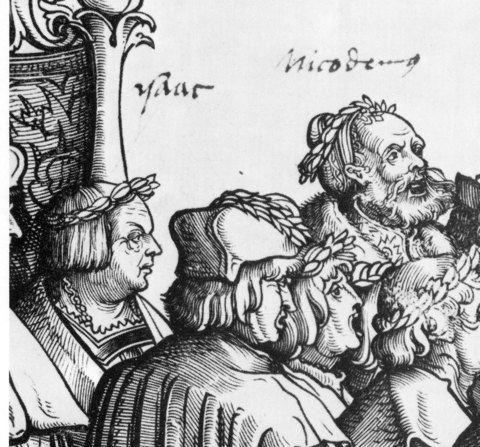G. Musical careers

Fig. Isaac and Nicodemus. Henricus Isaac and Nicodemus in the Triumphzug of Emperor Maximilian (c. 1520). Proof-sheet by Hans Burgkmair (detail). © Dresden, Staatliche Kunstsammlungen, Kupferstichkabinett. With permission. Under the leadership of chapelmaster Georg Slatkonia and court composer Henricus Isaac, internationally famous musicians collaborated in the imperial church services. The drawings of the musicians, to which a contemporary hand has added their names, may be made from life.
This main theme traces the paths of ten different musicians. Given the lack of reliable sources for his identity, the „Monk of Salzburg“ must be absent. The tragic fate of the physician Hermann Poll († 1401), who invented the harpsichord, is clearly recognizable from university documents and court chronicles. Hermann Pötzlinger (c 1420–1469) and Hermann Edlerawer (c 1390– c 1460) were musicians within circles around the University of Vienna: Pötzlinger worked as a music copyist and school principal, Edlerawer as cantor at St Stephen’s cathedral, composer and city official. Documentary evidence about the life of the famous poet and singer Oswald von Wolkenstein (1377 / 78–1445) has been collected in five volumes. He himself was involved in the transmission of his songs. Johannes Lupi (c 1405–1467) from Bozen was in the services of the Habsburgs and organist at the cathedral in Trent; he copied most of the older Trent Codices. Nikolaus Krombsdorfer (c. 1415–1488) worked for many years at the court of Ferrara and then became cantor at the Innsbruck court of Archduke Siegmund. Augustin Schubinger from Augsburg, an internationally celebrated performer on wind instruments as well as the lute, followed Maximilian I on many journeys. Jacob Obrecht (1457/58-1505), from Ghent, was already in 1486 a contributor to Maximilian’s festal ceremonies with his Mass cycle Salve diva parens. The famous Franco-Flemish composer Henricus Isaac (c. 1450–1517) enjoyed the patronage of the Medici in Florence before entering the service of Maximilian I. His most important compositions include a polyphonic gradual for all feasts and celebrations of the church year which was later published in print as the Choralis Constantinus. This project was supplemented by his student Ludwig Senfl (c. 1490–1543), who worked as a singer and composer first at the imperial court, then with Duke Wilhelm IV in Munich.
The essays marked with * are not yet available online.
Hermann Poll
Reinhard StrohmHermann Poetzlinger
Ian RumboldHermann Edlerawer
Ian RumboldOswald von Wolkenstein*
Marc LewonJohannes Lupi
Reinhard StrohmNicolaus Krombsdorfer
Reinhard StrohmJacob Obrecht*
Birgit LodesHenricus Isaac
Stefan GaschLudwig Senfl
Stefan Gasch